Exhumation of the Higher Himalaya: Insights from Detrital Zircon U–Pb Ages of the Oligocene–Miocene Chitarwatta Formation, Sulaiman Fold–Thrust Belt, Pakistan
Abstract
1. Introduction
2. Geological Setting
3. Stratigraphy and Petrography
4. U–Pb Geochronology
Sampling and Methods
5. U–Pb Geochronology Results
Chitarwatta Formation (Age~34 Ma)
6. Internal Zoning Pattern and Th/U Ratio
7. Discussion
7.1. Ages of the Source Terranes
7.2. Detrital Zircon Provenance of Chitarwatta Formation
7.3. Implications for Exhumation
8. Conclusions
Author Contributions
Funding
Institutional Review Board Statement
Informed Consent Statement
Data Availability Statement
Acknowledgments
Conflicts of Interest
References
- Ding, L.; Qasim, M.; Jadoon, I.A.; Khan, M.A.; Xu, Q.; Cai, F.; Wang, H.; Baral, U.; Yue, Y. The India–Asia collision in north Pakistan: Insight from the U–Pb detrital zircon provenance of Cenozoic foreland basin. Earth Planet. Sci. Lett. 2016, 455, 49–61. [Google Scholar] [CrossRef]
- DeCelles, P.G.; Giles, K.A. Foreland basin systems. Basin Res. 1996, 8, 105–123. [Google Scholar] [CrossRef]
- DeCelles, P.; Kapp, P.; Gehrels, G.; Ding, L. Paleocene-Eocene foreland basin evolution in the Himalaya of southern Tibet and Nepal: Implications for the age of initial India-Asia collision. Tectonics 2014, 33, 824–849. [Google Scholar] [CrossRef]
- Najman, Y. The detrital record of orogenesis: A review of approaches and techniques used in the Himalayan sedimentary basins. Earth-Sci. Rev. 2006, 74, 1–72. [Google Scholar] [CrossRef]
- Khan, I.H.; Clyde, W.C. Lower Paleogene Tectonostratigraphy of Balochistan: Evidence for Time-Transgressive Late Paleocene-Early Eocene Uplift. Geosciences 2013, 3, 466–501. [Google Scholar] [CrossRef]
- Myrow, P.; Hughes, N.; Paulsen, T.; Williams, I.; Parcha, S.; Thompson, K.; Bowring, S.; Peng, S.-C.; Ahluwalia, A. Integrated tectonostratigraphic analysis of the Himalaya and implications for its tectonic reconstruction. Earth Planet. Sci. Lett. 2003, 212, 433–441. [Google Scholar] [CrossRef]
- Najman, Y.; Garzanti, E.; Pringle, M.; Bickle, M.; Stix, J.; Khan, I. Early-Middle Miocene paleodrainage and tectonics in the Pakistan Himalaya. Geol. Soc. Am. Bull. 2003, 115, 1265–1277. [Google Scholar] [CrossRef]
- Awais, M.; Qasim, M.; Tanoli, J.I.; Ding, L.; Sattar, M.; Baig, M.S.; Pervaiz, S. Detrital Zircon Provenance of the Cenozoic Sequence, Kotli, Northwestern Himalaya, Pakistan; Implications for India–Asia Collision. Minerals 2021, 11, 1399. [Google Scholar] [CrossRef]
- Qasim, M.; Ahmad, J.; Ding, L.; Tanoli, J.I.; Sattar, M.; Rehman, Q.U.; Awais, M.; Umar, M.; Baral, U.; Khan, H. Integrated provenance and tectonic implications of the Cretaceous–Palaeocene clastic sequence, Changla Gali, Lesser Himalaya, Pakistan. Geol. J. 2021, 56, 4747–4759. [Google Scholar] [CrossRef]
- Qasim, M.; Ding, L.; Khan, M.A.; Baral, U.; Jadoon, I.A.; Umar, M.; Imran, M. Provenance of the Hangu Formation, Lesser Himalaya, Pakistan: Insight from the detrital zircon U-Pb dating and spinel geochemistry. Palaeoworld 2020, 29, 729–743. [Google Scholar] [CrossRef]
- Qasim, M.; Ding, L.; Khan, M.A.; Jadoon, I.A.; Haneef, M.; Baral, U.; Cai, F.; Wang, H.; Yue, Y. Tectonic implications of detrital zircon ages from lesser Himalayan Mesozoic-Cenozoic strata, Pakistan. Geochem. Geophys. Geosystems 2018, 19, 1636–1659. [Google Scholar] [CrossRef]
- Chen, Y.; Ding, L.; Li, Z.; Laskowski, A.K.; Li, J.; Baral, U.; Qasim, M.; Yue, Y. Provenance analysis of Cretaceous peripheral foreland basin in central Tibet: Implications to precise timing on the initial Lhasa-Qiangtang collision. Tectonophysics 2020, 775, 228311. [Google Scholar] [CrossRef]
- Armstrong-Altrin, J.S. Detrital zircon U–Pb geochronology and geochemistry of the Riachuelos and Palma Sola beach sediments, Veracruz State, Gulf of Mexico: A new insight on palaeoenvironment. J. Palaeogeogr. 2020, 9, 28. [Google Scholar] [CrossRef]
- Armstrong-Altrin, J.S.; Lee, Y.I.; Kasper-Zubillaga, J.J.; Carranza-Edwards, A.; Garcia, D.; Eby, G.N.; Balaram, V.; Cruz-Ortiz, N.L. Geochemistry of beach sands along the western Gulf of Mexico, Mexico: Implication for provenance. Geochemistry 2012, 72, 345–362. [Google Scholar] [CrossRef]
- Armstrong-Altrin, J.S.; Ramos-Vázquez, M.A.; Hermenegildo-Ruiz, N.Y.; Madhavaraju, J. Microtexture and U–Pb geochronology of detrital zircon grains in the Chachalacas beach, Veracruz State, Gulf of Mexico. Geol. J. 2021, 56, 2418–2438. [Google Scholar] [CrossRef]
- Fornelli, A.; Festa, V.; Micheletti, F.; Spiess, R.; Tursi, F. Building an Orogen: Review of U-Pb Zircon Ages from the Calabria–Peloritani Terrane to Constrain the Timing of the Southern Variscan Belt. Minerals 2020, 10, 944. [Google Scholar] [CrossRef]
- Fornelli, A.; Gallicchio, S.; Micheletti, F.; Langone, A. U–Pb detrital zircon ages from Gorgoglione Flysch sandstones in Southern Apennines (Italy) as provenance indicators. Geol. Mag. 2021, 158, 859–874. [Google Scholar] [CrossRef]
- Dew, R.E.; Collins, A.S.; Morley, C.K.; King, R.C.; Evans, N.J.; Glorie, S. Coupled detrital zircon U–Pb and Hf analysis of the Sibumasu Terrane: From Gondwana to northwest Thailand. J. Asian Earth Sci. 2021, 211, 104709. [Google Scholar] [CrossRef]
- Baral, U.; Lin, D.; Chamlagain, D. Detrital zircon U–Pb geochronology of the Siwalik Group of the Nepal Himalaya: Implications for provenance analysis. Int. J. Earth Sci. 2016, 105, 921–939. [Google Scholar] [CrossRef]
- DeCelles, P.; Gehrels, G.; Najman, Y.; Martin, A.; Carter, A.; Garzanti, E. Detrital geochronology and geochemistry of Cretaceous–Early Miocene strata of Nepal: Implications for timing and diachroneity of initial Himalayan orogenesis. Earth Planet. Sci. Lett. 2004, 227, 313–330. [Google Scholar] [CrossRef]
- Nazeer, A.; Solangi, S.H.; Brohi, I.A.; Usmani, P.; Napar, L.D.; Jahangir, M.; Hameed, S.; Ali, S.M. Hydrocarbon Potential Of Zinda Pir Anticline, Eastern Sulaiman Fold Belt, Middle Indus Basin, Pakistan. Pakista J. Hydrocarb. Res. 2013, 23, 73–84. [Google Scholar]
- Jadoon, I.; Zaib, M. Tectonic Map of Sulaiman Fold Belt: 1:500,000 Scale. In COMSATS; University Islamabad: Abbottabad, Pakistan, 2018. [Google Scholar]
- Ahmad, N. Palaeoenvironments, Diagenesis, and Geochemical Studies of the Dungan Formation (Palaeocene), Eastern Sulaiman Range, Pakistan; University of Leicester: Leicester, UK, 1996. [Google Scholar]
- Özcan, E.; Ali, N.; Hanif, M.; Hashmi, S.I.; Khan, A.; Yücel, A.O.; Abbasi, İ.A. A new Priabonian Heterostegina from the Eastern Tethys (Sulaiman Fold Belt, West Pakistan): Implications for the development of Eastern Tethyan heterostegines and their paleobiogeography. J. Foraminifer. Res. 2016, 46, 393–408. [Google Scholar] [CrossRef]
- Jadoon, I.A.; Lawrence, R.D.; Lillie3, R.J. Seismic data, geometry, evolution, and shortening in the active Sulaiman fold-and-thrust belt of Pakistan, southwest of the Himalayas. AAPG Bull. 1994, 78, 758–774. [Google Scholar]
- Zhuang, G.; Najman, Y.; Guillot, S.; Roddaz, M.; Antoine, P.-O.; Métais, G.; Carter, A.; Marivaux, L.; Solangi, S.H. Constraints on the collision and the pre-collision tectonic configuration between India and Asia from detrital geochronology, thermochronology, and geochemistry studies in the lower Indus basin, Pakistan. Earth Planet. Sci. Lett. 2015, 432, 363–373. [Google Scholar] [CrossRef]
- Jagoutz, O.; Schmidt, M.W. The formation and bulk composition of modern juvenile continental crust: The Kohistan arc. Chem. Geol. 2012, 298, 79–96. [Google Scholar] [CrossRef]
- Schelling, D.D. Frontal structural geometries and detachment tectonics of the. Himalaya Tibet. Mt. Roots Mt. Tops 1999, 328, 287. [Google Scholar]
- Klootwijk, C.; Conaghan, P.; Powell, C.M. The Himalayan Arc: Large-scale continental subduction, oroclinal bending and back-arc spreading. Earth Planet. Sci. Lett. 1985, 75, 167–183. [Google Scholar] [CrossRef]
- Saif-Ur-Rehman, K.J.; Ding, L.; Jadoon, I.A.; Baral, U.; Qasim, M.; Idrees, M. Interpretation of the Eastern Sulaiman fold-and-thrust belt, Pakistan: A passive roof duplex. J. Struct. Geol. 2019, 126, 231–244. [Google Scholar]
- Jadoon, I.A.; Khurshid, A. Gravity and tectonic model across the Sulaiman fold belt and the Chaman fault zone in western Pakistan and eastern Afghanistan. Tectonophysics 1996, 254, 89–109. [Google Scholar] [CrossRef]
- Lawrence, R.; Yeats, R.; Khan, S.; Farah, A.; DeJong, K. Thrust and strike slip fault interaction along the Chaman transform zone, Pakistan. Geol. Soc. Lond. Spec. Publ. 1981, 9, 363–370. [Google Scholar] [CrossRef]
- Jadoon, I.A.K. Thin-Skinned Tectonics on Continent/Ocean Transitional Crust, Sulaiman Range, Pakistan. Ph.D. Thesis, Oregon State University, Corvallis, OR, USA, 1991. [Google Scholar]
- Sarwar, G. Arcs, oroclines, syntaxis, the curvatures of mountain belts in Pakistan. Geodyn. Pak. 1979, 341–349. [Google Scholar]
- Gnos, E.; Immenhauser, A.; Peters, T. Late Cretaceous/early Tertiary convergence between the Indian and Arabian plates recorded in ophiolites and related sediments. Tectonophysics 1997, 271, 1–19. [Google Scholar] [CrossRef]
- Allemann, F. Time of emplacement of the Zhob Valley ophiolites and Bela ophiolites, Baluchistan (preliminary report). In Geodynamics of Pakistan; Geological Survey of Pakistan: Quetta, Pakistan, 1979; pp. 215–242. [Google Scholar]
- Iqbal, M.; Khan, M.R. Impact of Indo-Pakistan and Eurasian Plates Collision in the Sulaiman Fold Belt, Pakistan; Search and Discovery Article 50575; Datapage Inc.: Arleta, CA, USA, 2012. [Google Scholar]
- Humayon, M.; Lillie, R.J.; Lawrence, R.D. Structural interpretation of the eastern Sulaiman foldbelt and foredeep, Pakistan. Tectonics 1991, 10, 299–324. [Google Scholar] [CrossRef]
- Iqbal, M.; Helmcke, D. Geological interpretation of earthquakes data of Zindapir Anticlinorium, Sulaiman foldbelt, Pakistan. Pak. J. Hydrocarb. Res. 2004, 14, 41–47. [Google Scholar]
- Peresson, H.; Daud, F. Integrating Structural Geology and GIS: Wrench tectonics and exploration potential in the eastern Sulaiman fold belt. In Proceedings of the Pakistan Association of Petroleum Geoscientists (PAPG)/Society of Petroleum Engineers (SPE), Annual Technical Conference, Islamabad, Pakistan, 17–18 November 2009. [Google Scholar]
- Raza, H.A.; Ahmed, R.; Ali, S.M.; Ahmad, J. Petroleum prospects: Sulaiman sub-basin, Pakistan. Pak. J. Hydrocarb. Res. 1989, 1, 21–56. [Google Scholar]
- Dickinson, W.R. Interpreting provenance relations from detrital modes of sandstones. In Provenance of Arenites; Springer: Berlin/Heidelberg, Germany, 1985; pp. 333–361. [Google Scholar]
- Corfu, F.; Hanchar, J.M.; Hoskin, P.W.; Kinny, P. Atlas of zircon textures. Rev. Mineral. Geochem. 2003, 53, 469–500. [Google Scholar] [CrossRef]
- Sláma, J.; Košler, J.; Condon, D.J.; Crowley, J.L.; Gerdes, A.; Hanchar, J.M.; Horstwood, M.S.; Morris, G.A.; Nasdala, L.; Norberg, N. Plešovice zircon—A new natural reference material for U–Pb and Hf isotopic microanalysis. Chem. Geol. 2008, 249, 1–35. [Google Scholar] [CrossRef]
- Rubatto, D. Zircon: The metamorphic mineral. Rev. Mineral. Geochem. 2017, 83, 261–295. [Google Scholar] [CrossRef]
- Rubatto, D. Zircon trace element geochemistry: Partitioning with garnet and the link between U–Pb ages and metamorphism. Chem. Geol. 2002, 184, 123–138. [Google Scholar] [CrossRef]
- Gehrels, G.; Kapp, P.; DeCelles, P.; Pullen, A.; Blakey, R.; Weislogel, A.; Ding, L.; Guynn, J.; Martin, A.; McQuarrie, N. Detrital zircon geochronology of pre-Tertiary strata in the Tibetan-Himalayan orogen. Tectonics 2011, 30. [Google Scholar] [CrossRef]
- Ravikant, V.; Wu, F.-Y.; Ji, W.-Q. U–Pb age and Hf isotopic constraints of detrital zircons from the Himalayan foreland Subathu sub-basin on the Tertiary palaeogeography of the Himalaya. Earth Planet. Sci. Lett. 2011, 304, 356–368. [Google Scholar] [CrossRef]
- Cai, F.; Ding, L.; Yue, Y. Provenance analysis of upper Cretaceous strata in the Tethys Himalaya, southern Tibet: Implications for timing of India–Asia collision. Earth Planet. Sci. Lett. 2011, 305, 195–206. [Google Scholar]
- Hu, X.; Wang, J.; BouDagher-Fadel, M.; Garzanti, E.; An, W. New insights into the timing of the India–Asia collision from the Paleogene Quxia and Jialazi formations of the Xigaze forearc basin, South Tibet. Gondwana Res. 2016, 32, 76–92. [Google Scholar] [CrossRef]
- Qasim, M.; Tanoli, J.I.; Ahmad, L.; Ding, L.; Rehman, Q.U.; Umber, U. First U-Pb Detrital Zircon Ages from Kamlial Formation (Kashmir, Pakistan): Tectonic Implications for Himalayan Exhumation. Minerals 2022, 12, 298. [Google Scholar] [CrossRef]
- Ji, W.-Q.; Wu, F.-Y.; Chung, S.-L.; Li, J.-X.; Liu, C.-Z. Zircon U–Pb geochronology and Hf isotopic constraints on petrogenesis of the Gangdese batholith, southern Tibet. Chem. Geol. 2009, 262, 229–245. [Google Scholar] [CrossRef]
- Ravikant, V.; Wu, F.-Y.; Ji, W.-Q. Zircon U–Pb and Hf isotopic constraints on petrogenesis of the Cretaceous–Tertiary granites in eastern Karakoram and Ladakh, India. Lithos 2009, 110, 153–166. [Google Scholar] [CrossRef]
- Colleps, C.L.; McKenzie, N.R.; Horton, B.K.; Webb, A.A.G.; Ng, Y.W.; Singh, B.P. Sediment provenance of pre- and post-collisional Cretaceous–Paleogene strata from the frontal Himalaya of northwest India. Earth Planet. Sci. Lett. 2020, 534, 116079. [Google Scholar] [CrossRef]
- Najman, Y.; Bickle, M.; BouDagher-Fadel, M.; Carter, A.; Garzanti, E.; Paul, M.; Wijbrans, J.; Willett, E.; Oliver, G.; Parrish, R.; et al. The Paleogene record of Himalayan erosion: Bengal Basin, Bangladesh. Earth Planet. Sci. Lett. 2008, 273, 1–14. [Google Scholar] [CrossRef]
- Roddaz, M.; Said, A.; Guillot, S.; Antoine, P.-O.; Montel, J.-M.; Martin, F.; Darrozes, J. Provenance of Cenozoic sedimentary rocks from the Sulaiman fold and thrust belt, Pakistan: Implications for the palaeogeography of the Indus drainage system. J. Geol. Soc. 2011, 168, 499–516. [Google Scholar] [CrossRef]
- Shah, S.I. Stratigraphy of Pakistan; Government of Pakistan Ministry of Petroleum & Natural Resorces Geological Survey of Pakistan: Islamabad, Pakistan, 2009.
- Sabins, F.F. Remote sensing for mineral exploration. Ore Geol. Rev. 1999, 14, 157–183. [Google Scholar] [CrossRef]
- Ding, L.; Kapp, P.; Wan, X. Paleocene-Eocene record of ophiolite obduction and initial India-Asia collision, south central Tibet. Tectonics 2005, 24. [Google Scholar] [CrossRef]
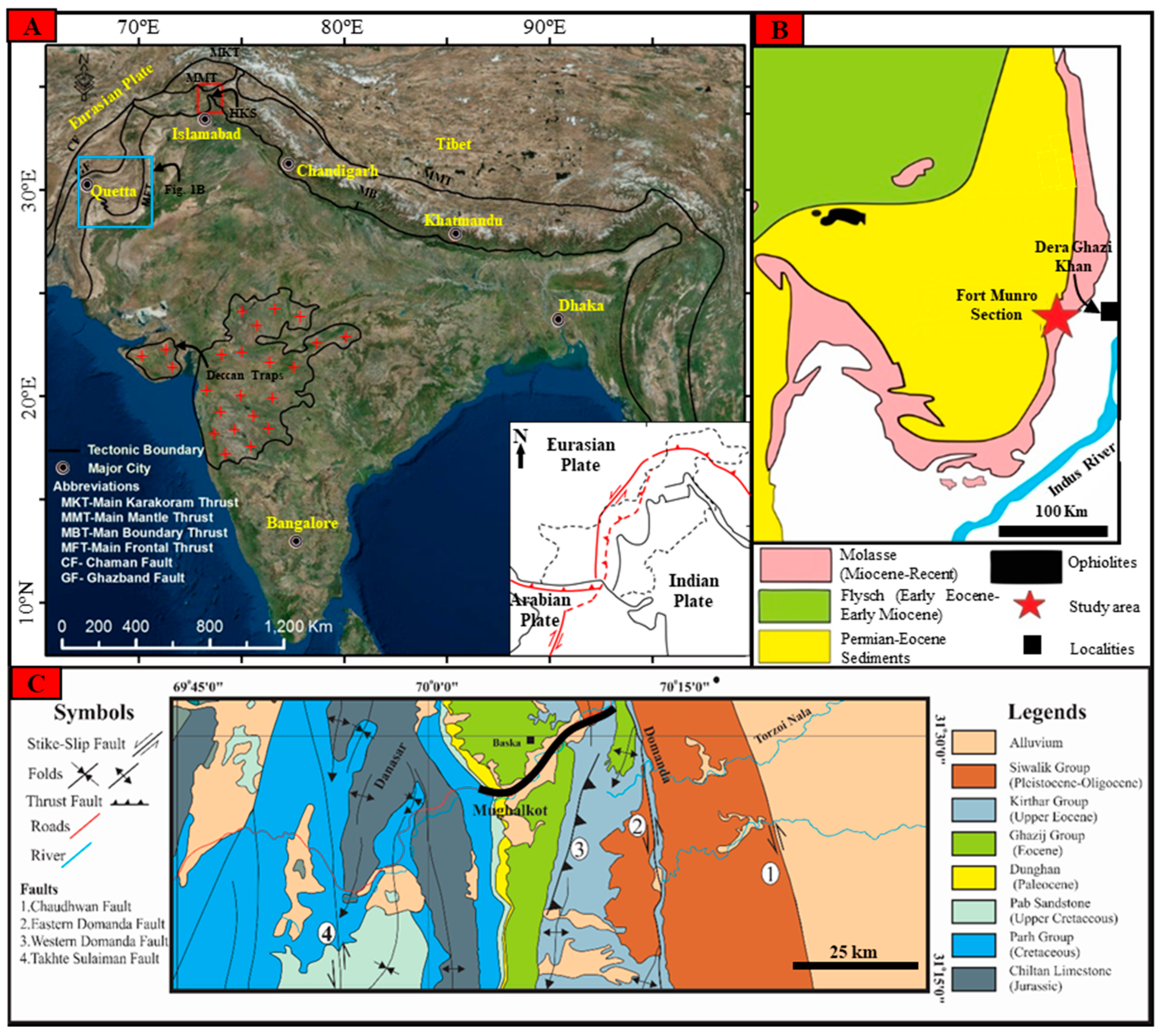
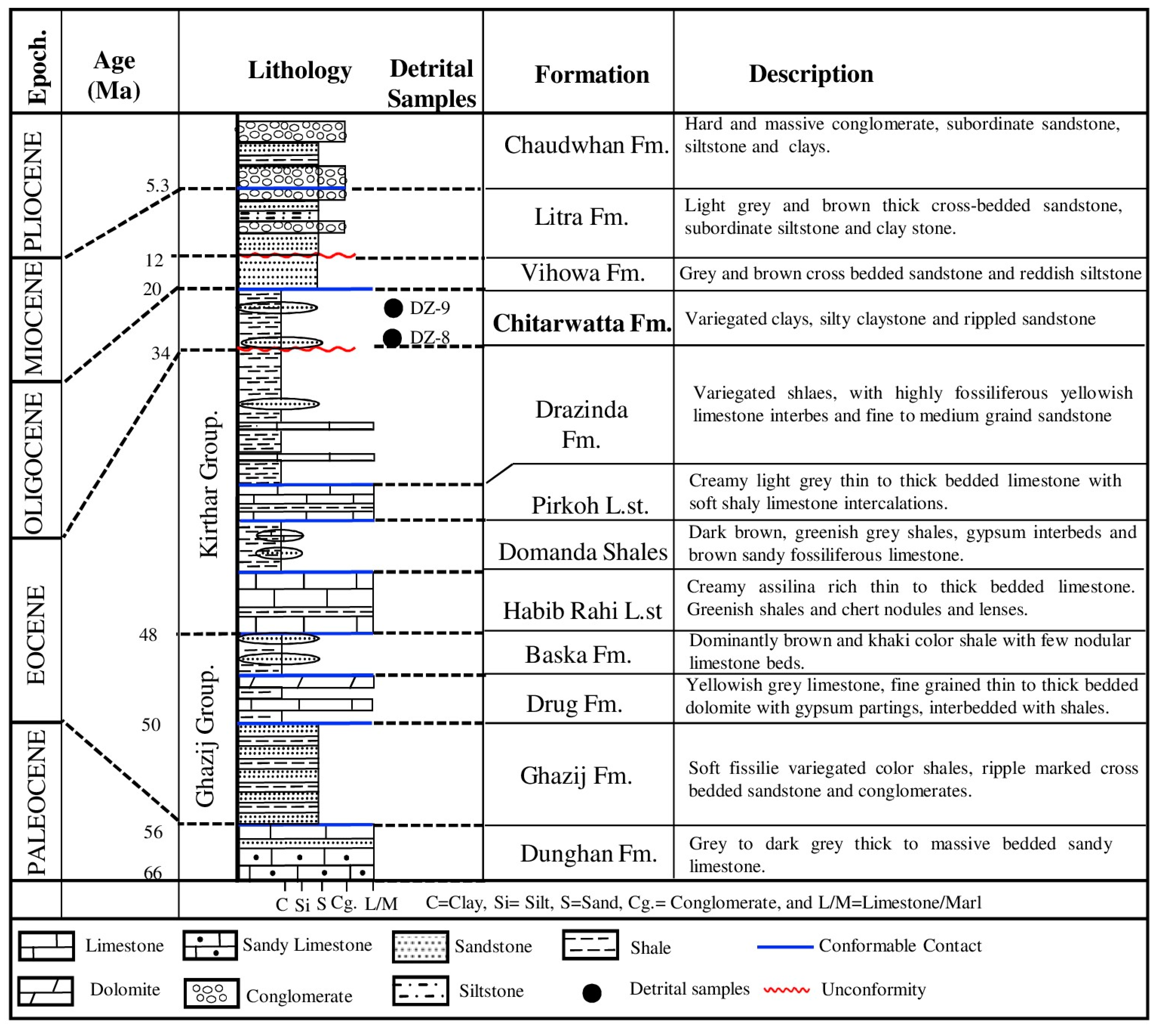
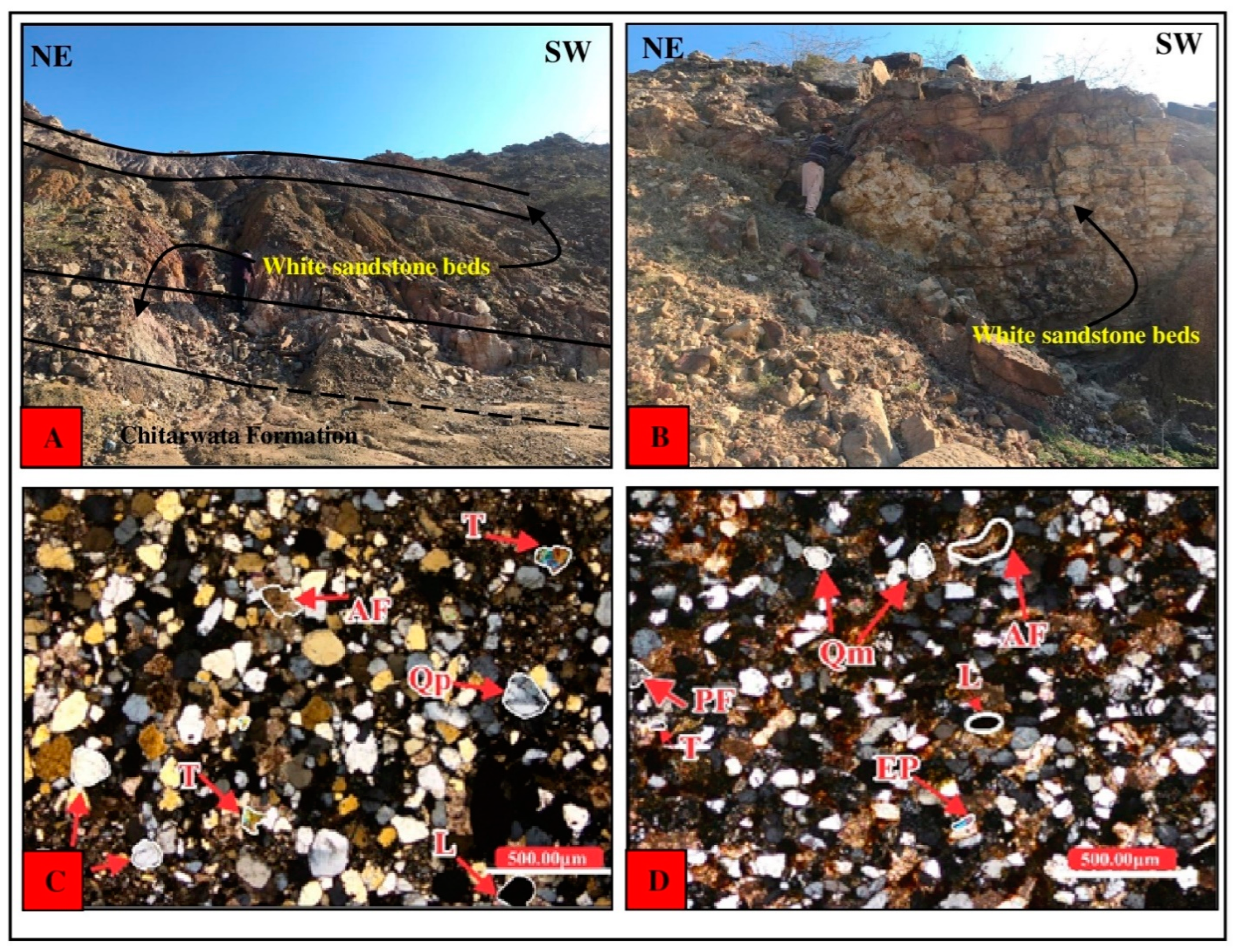

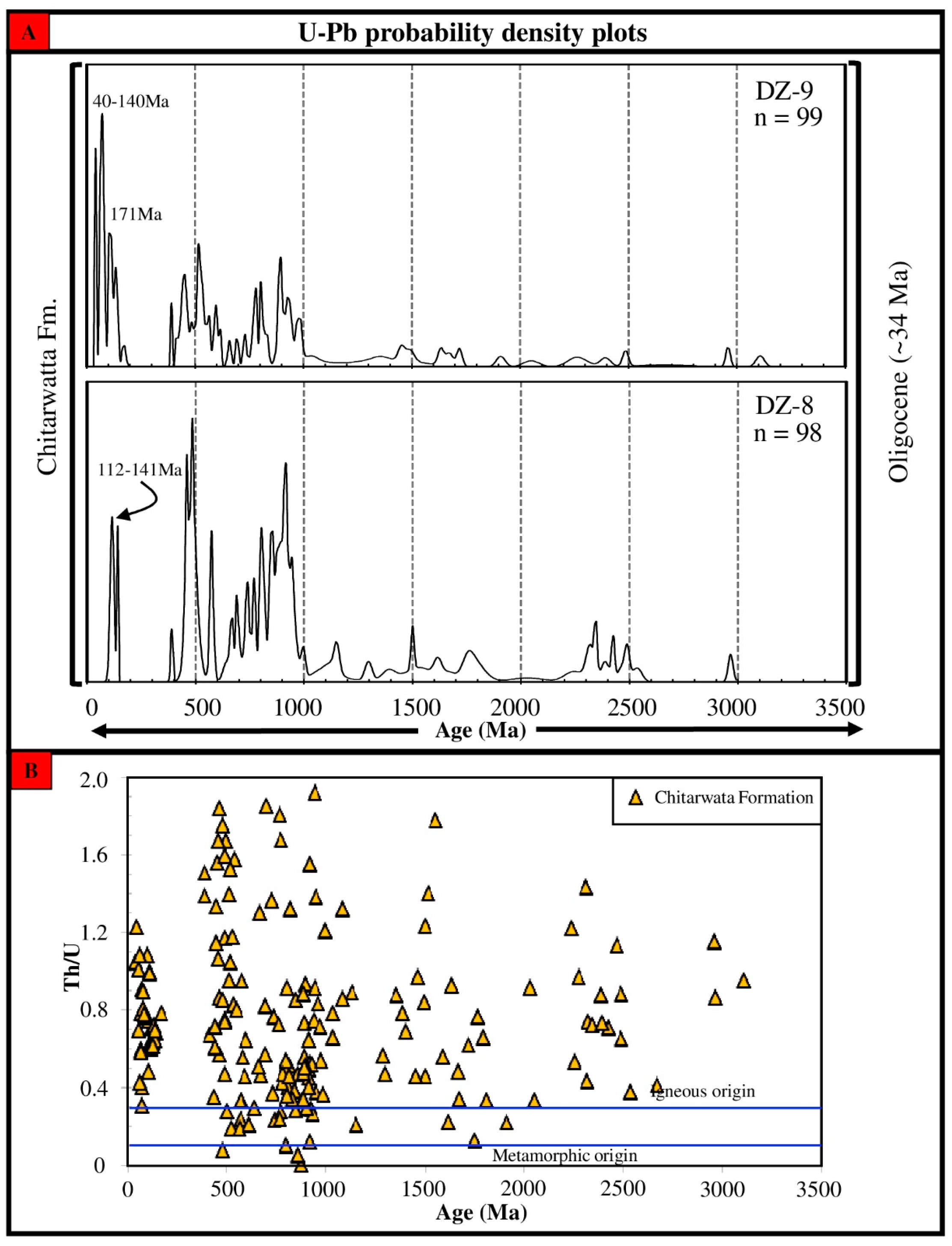
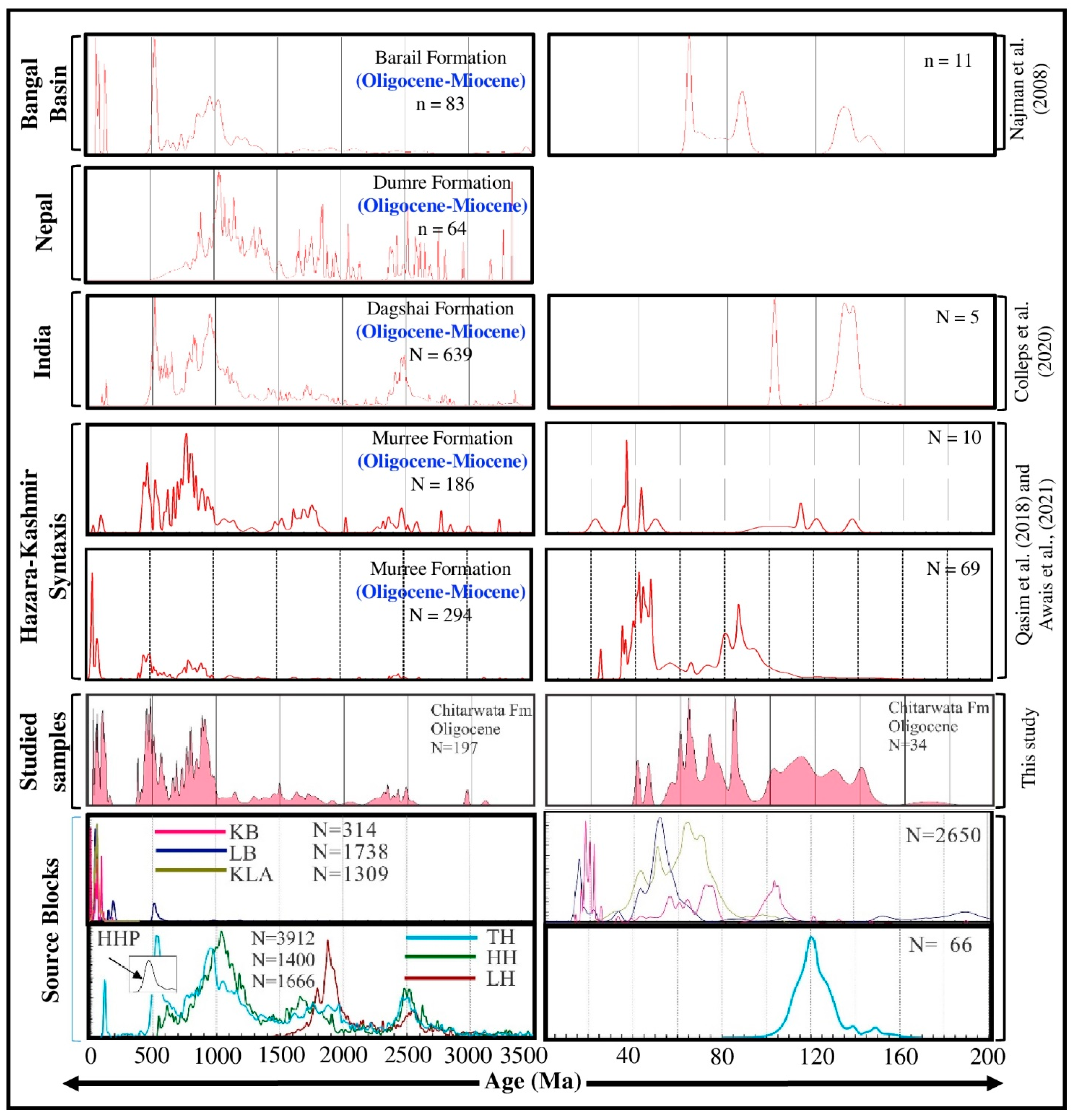
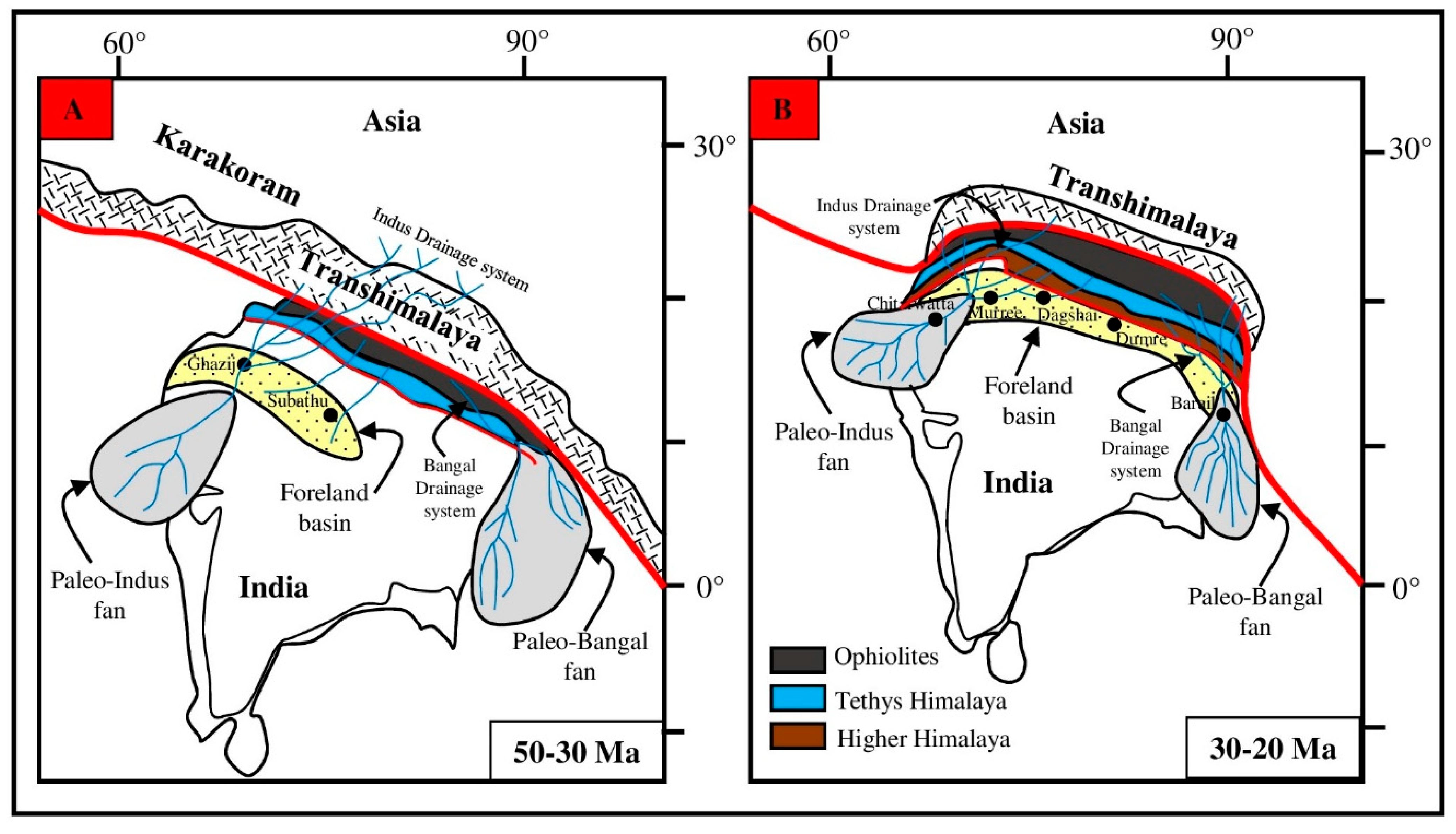
| Formation Name | Sample No. | Quartz | Feldspar | Lithics | Matrix/Cement | Accessory Minerals | Bioclast | Percentage Composition Framework Grains | |||||||||||||
|---|---|---|---|---|---|---|---|---|---|---|---|---|---|---|---|---|---|---|---|---|---|
| Qm | Qp | Q | Pf | Af | F | Ls | Lm | Li | Clay | Calcite | Epidote | Tourmaline | Q | F | L | Qm | F | L | |||
| Chitarwata Formation | DZ-8 | 319 | - | 319 | 1 | 24 | 25 | 45 | - | - | 3% | 10% | 3 | 8 | - | 82 | 6 | 12 | 82 | 6 | 12 |
| DZ-9 | 315 | 1 | 316 | 1 | 46 | 47 | 35 | - | - | 3% | 15% | 1 | 1 | - | 79 | 12 | 9 | 79 | 12 | 9 | |
| Formation Name | Sample No. | Grain Shape | Fabric Support/Contacts | Sorting | Maturity | ||
|---|---|---|---|---|---|---|---|
| Roundness | Sphericity | Textural | Mineralogical | ||||
| Chitarwata Formation | DZ-8 | Sub angular-Sub rounded | Low-Medium | Grain supported, Planar-Pointed contacts | Well sorted | Mature | Mature |
| DZ-9 | Sub angular-Sub rounded | Low-Medium | Grain supported, Planar-Pointed contacts | Well sorted | Mature | Mature | |
Disclaimer/Publisher’s Note: The statements, opinions and data contained in all publications are solely those of the individual author(s) and contributor(s) and not of MDPI and/or the editor(s). MDPI and/or the editor(s) disclaim responsibility for any injury to people or property resulting from any ideas, methods, instructions or products referred to in the content. |
© 2023 by the authors. Licensee MDPI, Basel, Switzerland. This article is an open access article distributed under the terms and conditions of the Creative Commons Attribution (CC BY) license (https://creativecommons.org/licenses/by/4.0/).
Share and Cite
Qasim, M.; Tayyab, O.; Ding, L.; Tanoli, J.I.; Bhatti, Z.I.; Umar, M.; Khan, H.; Ashraf, J.; Jadoon, I.A.K. Exhumation of the Higher Himalaya: Insights from Detrital Zircon U–Pb Ages of the Oligocene–Miocene Chitarwatta Formation, Sulaiman Fold–Thrust Belt, Pakistan. Appl. Sci. 2023, 13, 3418. https://doi.org/10.3390/app13063418
Qasim M, Tayyab O, Ding L, Tanoli JI, Bhatti ZI, Umar M, Khan H, Ashraf J, Jadoon IAK. Exhumation of the Higher Himalaya: Insights from Detrital Zircon U–Pb Ages of the Oligocene–Miocene Chitarwatta Formation, Sulaiman Fold–Thrust Belt, Pakistan. Applied Sciences. 2023; 13(6):3418. https://doi.org/10.3390/app13063418
Chicago/Turabian StyleQasim, Muhammad, Owais Tayyab, Lin Ding, Javed Iqbal Tanoli, Zahid Imran Bhatti, Muhammad Umar, Hawas Khan, Junaid Ashraf, and Ishtiaq Ahmad Khan Jadoon. 2023. "Exhumation of the Higher Himalaya: Insights from Detrital Zircon U–Pb Ages of the Oligocene–Miocene Chitarwatta Formation, Sulaiman Fold–Thrust Belt, Pakistan" Applied Sciences 13, no. 6: 3418. https://doi.org/10.3390/app13063418
APA StyleQasim, M., Tayyab, O., Ding, L., Tanoli, J. I., Bhatti, Z. I., Umar, M., Khan, H., Ashraf, J., & Jadoon, I. A. K. (2023). Exhumation of the Higher Himalaya: Insights from Detrital Zircon U–Pb Ages of the Oligocene–Miocene Chitarwatta Formation, Sulaiman Fold–Thrust Belt, Pakistan. Applied Sciences, 13(6), 3418. https://doi.org/10.3390/app13063418





